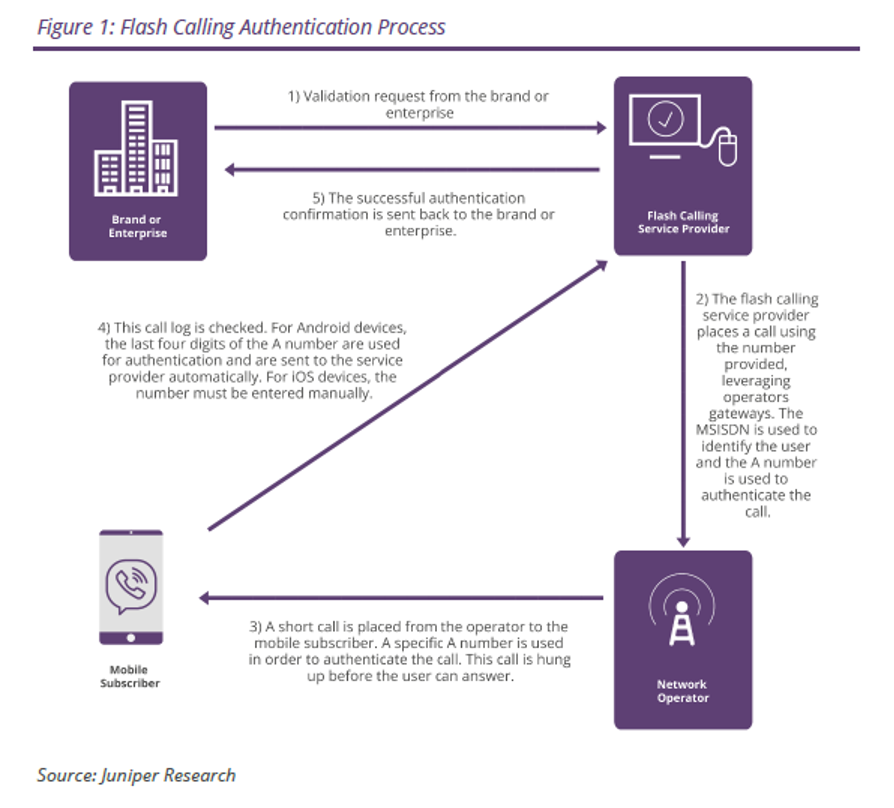According to a recent report by Juniper Networks, the adoption of Flash Calling Authentication (FCA) is about to soar big time. A 185,000% increase in the next five years – big time – as the analyst house projects the number of calls used for FCA will near 130 billion globally by 2026, rising from less than 60 million in 2021. Richard discusses what is driving this rise and how to prepare for the associated threats.
Flash calling authentication leverages mobile voice networks to authenticate a user or transaction via an originating phone number. Selected digits of this phone number are then automatically used for authentication, rather than requiring a user to manually input a code that is delivered by SMS. This makes it a convenient user experience for consumers because it is faster than SMS or email, doesn’t require the user to do anything, and reduces the risk of the content of an SMS being intercepted. This will be particularly attractive to enterprises in the banking and financial sectors and e-commerce.

However, the popularity of Flash Calling Authentication creates a significant threat to A2P SMS revenues. The report predicts that authentication-based SMS revenue will reach $39 billion globally in 2022, representing 5% of total operator-billed revenue. This leaves operators in a position where they need to support services over both SMS and flash calling to protect their authentication-related revenue. What’s more, flash calling authentication revenue will not simply replace SMS revenue because the calls are identified as missed calls; therefore, receiving operators do not collect termination fees. Instead, operators will need to develop new business models to ensure flash traffic is included in contracts. But these considerations all come to naught as many operators are unable to identify flash calling traffic in order to monetize it.
This is where the urgency for adopting voice firewalls comes into play. Voice firewalls are critical to detect unmonetized flash calling traffic to prevent the erosion of A2P revenues. While voice firewalls are essential to capture flash calling traffic revenue, they also play a critical role in protecting mobile networks from threats by fraudulent players, such as grey route SMS and robocalling. For these reasons, voice firewalls are critical to not only protect authentication revenue but also to protect your subscribers from fraud.
Mobileum’s Voice Firewall handles both legacy, and IP interconnects, with the capability to communicate in CAMEL, INAP, and SIP/SIP-I, bringing the ability to understand call routing, adding the capability of call context analysis to check for context misbehavior. For example, an MT call, with a calling number that belongs to the country’s fixed-line number range, cannot reach the operator on the international mobile gateway. Our Voice Firewall leverages all of Mobileum’s expertise on national and international voice traffic, signaling security, and fraud management expertise together with the STIR/SHAKEN framework, to ensure the calling number of a telephone call is secure without wrongly blocking or marking legit users or companies as spam. Its integration with Mobileum’s fraud management system delivers advanced analytics, enabling fraud teams to identify high-risk behavior patterns in near real-time.
As enterprises migrate their A2P from SMS to Flash Calling, operators must put the systems in place to protect their authentication revenues. To learn more about Mobileum’s Voice Firewall, contact us.

.png?width=60&name=Square%20340x340%20(1).png)


Let Us Know What You Thought about this Post.
Put your Comment Below.